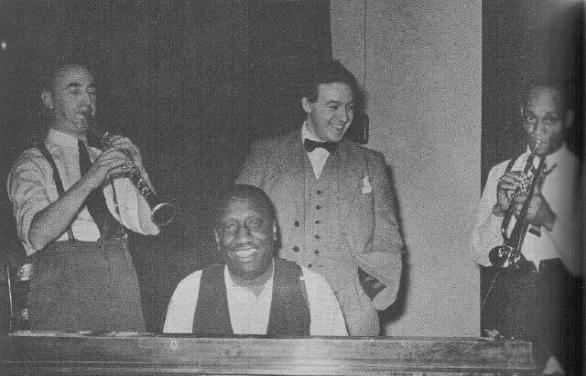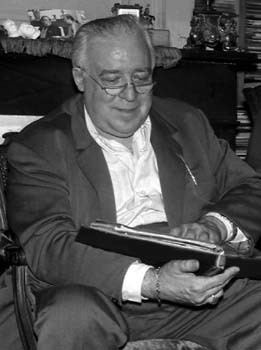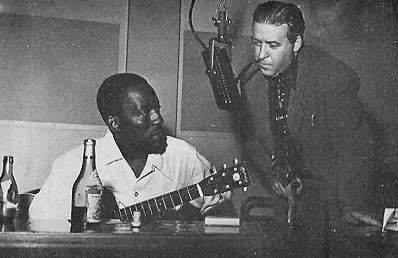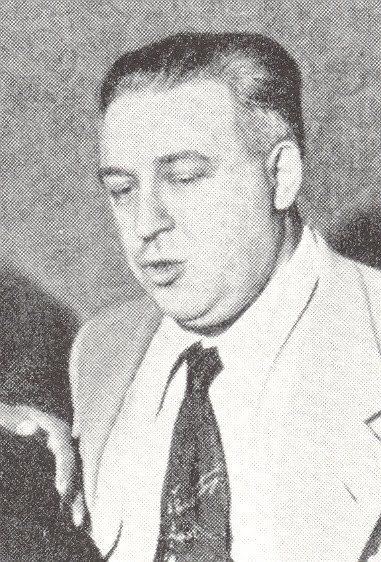Name Hugues Panassie | ||
 | ||
Books The Real Jazz, Dictionnaire du jazz, Louis Armstrong Similar People Joseph Reinhardt, Django Reinhardt, Hubert Rostaing | ||
Louis Armstrong, January 1933: Some Sweet Day - "Hugues Panassie's Guide To Jazz"
Hugues Panassié (27 February 1912, Paris – 8 December 1974) was an influential French critic, record producer, and impresario of traditional jazz.
Contents
- Louis Armstrong January 1933 Some Sweet Day Hugues Panassies Guide To Jazz
- Basie One Oclock Boogie 1947 Bechet Shake It And Break It 1940 Hugues Panassie
- Career
- Selected controversies
- Panassis political bent
- Discography
- Books
- Family
- References

Basie: One O'clock Boogie, 1947; Bechet, Shake It And Break It, 1940 - Hugues Panassie
Career

Panassié was born in Paris. When he was fourteen, he was stricken with polio, which limited his extracurricular physical activities. He took-up the saxophone and fell in love with jazz in the late 1920s.

Panassié was the founding president of the Hot Club de France (1932).

During World War II, the Germans occupied the northern half of France beginning June 1940. The Nazi's regarded jazz as low music — music from an inferior people. Jacques Demetre, in the 2014 book by Steve Cushing, Pioneers of the Blues Revival, said that people had expected the Germans to ban jazz entirely. But instead, they only banned American jazz and American tunes. Demetre explained that many American standards were in French with alternate titles. Panassié, for example, managed to keep broadcasting American jazz on his radio station submitting to censors obtuse French translations American song titles, and even relabeling records. Panassié's friend, Mezz Mezzrow, describes a particular example in his 1946 autobiography Really the Blues:

Panassié produced several jazz records by artists that include Sidney Bechet and Tommy Ladnier.
Selected controversies

In a changing world of jazz, Panassié was an ardent exponent of traditional jazz — strictly Dixieland. He harbored a particular love of style similar to that of Louis Armstrong from the 1930s. Panassié criticized West Coast jazz as inauthentic, partly because most musicians were white and also sounded white. In his book, The Real Jazz, Panassié ranked Benny Goodman as a detestable clarinetist whose sterile intonation was inferior to black players Jimmy Noone and Omer Simeon. Mezz Mezzrow became Panassié's lone example of a white musician who played jazz authentically. Panassié famously dismissed bebop as "a form of music distinct from jazz."

In 1974, he accused Miles Davis, Archie Shepp, Pharoah Sanders, and other progressives as being "traitors to the cause of true black music," that, according to Panassié, they claimed to support.
Some historians opine that Panassié hurt musicians by creating a wedge between blacks and whites by his insistence that black jazz was superior. Some authors ridicule his harsh attacks against progressive jazz critics, who he characterized in his Bulletin du Hot Club de France as being full of "crass ignorance," "thick incompetence," and "triumphant stupidity." His ad hominem attacks included phrases that translate to "repugnant glavioteur," "formidable imbecile," and "donkey of the pen."
Panassié's political bent
In addition to being strong exponent of Dixieland jazz, and harsh critic of jazz musicians who strayed from it, Panassié was an arch-conservative — a staunch monarchist, to the far right of the right. And, he contributed articles to Action Française.
Discography
In 1956, RCA Victor published an LP record, Guide to Jazz (LPM 1393), a compilation including 16 recordings by prominent jazz artists with liner notes by Panassiè.
Books
Books by Panassié
Family
Panassié spent five months in New York City in the company of Madeleine Gautier, his assistant. In 1949, they married, returned to France, and settled in Montauban at 65 Faubourg du Moustier.
